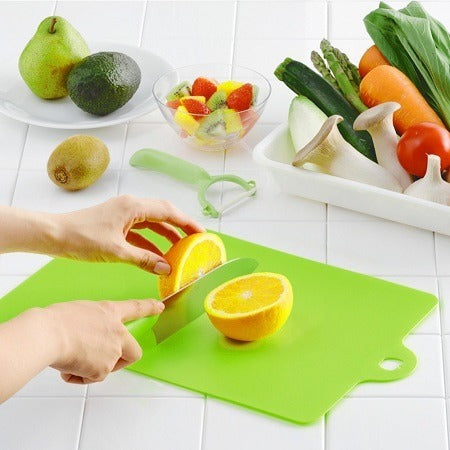Why a Plastic Cutting Board Isn’t as Useful as We Once Thought
Almost every house at one point or another has had a plastic cutting board in their kitchen. These cheap kitchen items have long been used to prepare meats, vegetables, and other ingredients while protecting our benchtops from damage. But how useful are they really, and what alternatives are there in the market today?
For something that we use daily in our lives, selecting the right material for your chopping board is essential. While it may be easy enough to purchase a cheap plastic board and assume it will serve you well, there are many other factors that need to be considered.
Plastic cutting boards are just one of a few popular types found today, each with their own unique selling points and disadvantages to the user. By comparing their features we can see which boards are superior, and the hidden dangers behind some of these common materials.

Plastic Cutting Boards
While a plastic cutting board may be the first choice for many due to their affordability, they may doing your kitchen more harm than good. Plastic cutting boards are very simple to clean and you can either place them in the dishwasher or wash them as usual with your other dishes.
Although they’re easy to keep clean, you will need to replace them at least once a year to keep them at their cleanest. While plastic can be durable, constant use will cause large marks and dents which are more prone to trapping harmful germs and bacteria.
Studies have shown that when compared to wooden cutting boards, plastic harbours more of these harmful bacteria, such as salmonella and listeria. This goes against longstanding beliefs that this material is more hygienic than wood, as it is now considered one of the most unhygienic choices for cutting boards.
Many people choose to have a plastic board in their house alongside a quality wooden one, to be kept for emergencies. However, with wooden cutting boards becoming more common and desired, plastic cutting boards may soon become a thing of the past.
Stone Cutting Boards
A stone cutting board consists of a group of different materials, such as granite and marble, which are generally found on benchtops rather than food preparation utensils. Although these materials are known for their strength, as cutting boards they’re not as durable as one may think.
Not only will a stone cutting board receive damage from your knife and show up with scratches that are impossible to remove, but your knife will also become affected by using it with this material. You may find that you’re needing to sharpen your blades constantly, eventually leaving nothing left of even the strongest knives.
There are some advantages, though, as keeping a stone cutting board clean is quite simple. Due to their tough surface, you’re able to soak them in water or wash them intensely to achieve a deep clean. If you’re after something low maintenance and not concerned about the potential damage to your knives, these might be for you.
Steel Cutting Boards
Not as common as the other types, but still found in some kitchens, a steel cutting board is generally constructed from the stainless variety. While stainless steel is known for being hygienic and extremely easy to maintain and clean, the practicality of using one against a sharp knife is just not viable.

When cutting ingredients on a steel board, there will be significant noise which can be compared to running your fingernails down a chalkboard. Not only will this be irritating, but your knife will likely slip around as it finds it hard to grip onto the sleek surface causing more kitchen accidents than the other types.
Steel cutting boards will significantly damage your knives, just as glass varieties will, so while the board itself may last your cooking utensils will not. While steel may be ideal for preparing other foods, such as dough or baking, it’s not a smart choice for a cutting board material.
Wood Cutting Boards
There are many species of wood available which make great cutting boards. For something that is as durable and stylish as the more expensive types but at a fraction of the price, opt for a wood such as acacia.
Traditionally, a popular belief has been that plastic is far more hygienic than wood in terms of cutting board quality. More recent studies have shown, however, that wood works far better at keeping bacteria at bay.
These studies placed bacteria such as salmonella on different materials and left them for varying periods, with the wood varieties showing no signs of these harmful organisms the following day.
Not only is wood hygienic, it is far more visually pleasing than the other types. A quality wooden board is ideal for cutting and preparing food but can also serve as a unique platter for entertaining guests.
While they do cost a little more than the other materials, the extra price is certainly worth it. With a little upkeep and regular cleaning, these wooden cutting boards will last many years more than a plastic one.
The Verdict
For a product that’s durable, affordable, and visually stunning, a wood cutting board is the top pick for your kitchen. Hardwood has long been considered the material of choice for many construction projects and household furniture, making it a smart choice for a strong cutting board too.
While many people assume that wood is one of the most unhygienic materials used in food preparation, it is full of natural antibacterial qualities which make it ideal for this purpose. With the correct care and maintenance, you can ensure that a wooden cutting board lasts for many years and never loses its original shine.

Not only do wooden cutting boards have many practical advantages over the other materials, their appearance far exceeds the others as well. These wooden boards are perfect for adding rustic charm and understated class to your kitchen and home.

